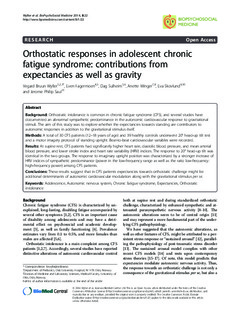| dc.contributor.author | Wyller, Vegard Bruun | |
| dc.contributor.author | Fagermoen, Frode Even | |
| dc.contributor.author | Sulheim, Dag | |
| dc.contributor.author | Winger, Anette | |
| dc.contributor.author | Skovlund, Eva | |
| dc.contributor.author | Saul, J. Philip | |
| dc.date.accessioned | 2015-02-10T13:04:01Z | |
| dc.date.accessioned | 2015-02-24T11:17:24Z | |
| dc.date.available | 2015-02-10T13:04:01Z | |
| dc.date.available | 2015-02-24T11:17:24Z | |
| dc.date.issued | 2014 | |
| dc.identifier.citation | BioPsychoSocial Medicine 2014, 8 | |
| dc.identifier.issn | 1751-0759 | |
| dc.identifier.uri | http://hdl.handle.net/11250/277464 | |
| dc.description | - | |
| dc.description.abstract | Background: Orthostatic intolerance is common in chronic fatigue syndrome (CFS), and several studies have documented an abnormal sympathetic predominance in the autonomic cardiovascular response to gravitational stimuli. The aim of this study was to explore whether the expectancies towards standing are contributors to autonomic responses in addition to the gravitational stimulus itself.
Methods: A total of 30 CFS patients (12–18 years of age) and 39 healthy controls underwent 20° head-up tilt test and a motor imagery protocol of standing upright. Beat-to-beat cardiovascular variables were recorded.
Results: At supine rest, CFS patients had significantly higher heart rate, diastolic blood pressure, and mean arterial blood pressure, and lower stroke index and heart rate variability (HRV) indices. The response to 20° head-up tilt was identical in the two groups. The response to imaginary upright position was characterized by a stronger increase of HRV indices of sympathetic predominance (power in the low-frequency range as well as the ratio low-frequency: high-frequency power) among CFS patients.
Conclusions: These results suggest that in CFS patients expectancies towards orthostatic challenge might be additional determinants of autonomic cardiovascular modulation along with the gravitational stimulus per se. | |
| dc.language.iso | eng | |
| dc.relation.uri | http://www.bpsmedicine.com/content/pdf/1751-0759-8-22.pdf | |
| dc.title | Orthostatic responses in adolescent chronic fatigue syndrome: Contributions from expectancies as well as gravity | |
| dc.type | Journal article | |
| dc.date.updated | 2015-02-10T13:04:00Z | |
| dc.subject.nsi | VDP::Medisinske fag: 700::Helsefag: 800::Epidemiologi medisinsk og odontologisk statistikk: 803 | |
| dc.subject.nsi | VDP::Midical sciences: 700::Health sciences: 800::Epidemiology, medical and dental statistics: 803 | |
| dc.identifier.doi | 10.1186/1751-0759-8-22 | |
| dc.identifier.cristin | 1173512 | |
